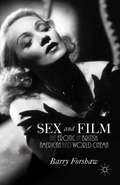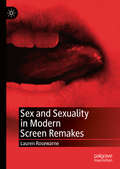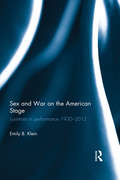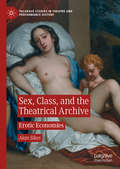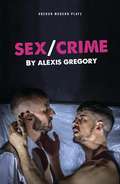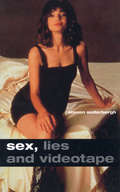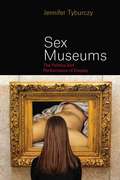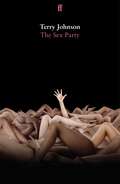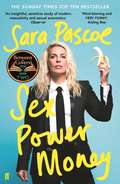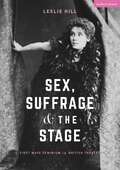- Table View
- List View
Sex and Film: The Erotic in British, American and World Cinema
by B. ForshawSex and Film is a frank, comprehensive analysis of the cinema's love affair with the erotic. Forshaw's lively study moves from the sexual abandon of the 1930s to filmmakers' circumvention of censorship, the demolition of taboos by arthouse directors and pornographic films, and an examination of how explicit imagery invaded modern mainstream cinema.
Sex and Sexualities in Ireland: Interdisciplinary Perspectives (Genders and Sexualities in the Social Sciences)
by Barbara Górnicka Mark DoyleThis edited collection provides an invaluable resource of seventeen chapters from a wide range of academic disciplines. These chapters place sex and sexualities in Ireland in historical context and take the reader through the structural changes that have transformed the expression of sexuality in Ireland from one of self-denial to self-expression. The collection does not however unquestionably assume a linear narrative of progress: new issues and challenges are also addressed throughout. This book will be of interest to students and scholars from a range of disciplines including sociology, social policy, history, media, gender studies and psychology. The collection is divided into six separate but interlinked thematic sections: Sexualities in Historical Irish Contexts, Young Adults, Sexual Health, and Education, Sexual Practices and Health, Minority Sexualities and Genders, Sex Work in Ireland and Activism and Contestation.
Sex and Sexuality in Modern Screen Remakes
by Lauren RosewarneSex and Sexuality in Modern Screen Remakes examines how sexiness, sexuality and revisited sexual politics are used to modernize film and TV remakes. This exploration provides insight into the ever-evolving—and ever-contested—role of sex in society, and scrutinizes the politics and economics underpinning modern media reproduction. More nudity, kinky sex, and queer content are increasingly deployed in remakes to attract, and to titillate, a new generation of viewers. While sex in this book refers to increased erotic content, this discussion also incorporates an investigation of other uses of sex and gender to help a remake appear woke and abreast of the zeitgeist including feminist reimaginings and ‘girl power’ make-overs, updated gender roles, female cast-swaps, queer retellings, and repositioned gazes. Though increased sex is often considered a sign of modernity, gratuitous displays of female nudity can sometimes be interpreted as sexist and anachronistic, in turn highlighting that progressiveness around sexuality in contemporary media is not a linear story. Also examined therefore, are remakes that reduce the sexual content to appear cutting-edge and cognizant of the demands of today’s audiences.
Sex and Storytelling in Modern Cinema: Explicit Sex, Performance and Cinematic Technique (International Library Of The Moving Image Ser.)
by Editor Lindsay ColemanWith full-frontal genitalia, erections, even actual sex featuring increasingly in films, this explicitness in presentation has caused critical consternation and accusations that such film narratives are pornographic. This book explores how, rather than being pornographic, explicit sex can be an essential element of cinematic storytelling today.Offering detailed analysis of how choices are made in the presentation of explicit sex in often very controversial films, such as Shame, Baise-Moi, Antichrist, Dogtooth and Lust,Caution, the expert contributors - including Barbara Creed, Jacob Held and Linda Ruth Williams - show how sexual content can aid characterisation, highlight themes, and provide events that serve to develop plot. The impact of explicit sex as an element of a film's narrative is also revealed to be assisted by effective, nuanced performances and the incisive deployment of directorial technique. Together they detail through the fundamentals of cinema the shot by shot, moment by moment manner in which explicit sex can be an essential component of a dramatically powerful narrative.
Sex and Storytelling in Modern Cinema: Explicit Sex, Performance and Cinematic Technique
by Lindsay ColemanWith full-frontal genitalia, erections, even actual sex featuring increasingly in films, this explicitness in presentation has caused critical consternation and accusations that such film narratives are pornographic. This book explores how, rather than being pornographic, explicit sex can be an essential element of cinematic storytelling today. Offering detailed analysis of how choices are made in the presentation of explicit sex in often very controversial films, such as "Shame", "Baise-Moi", "Antichrist", "Dogtooth" and "Lust, Caution", the expert contributors - including Barbara Creed, Jacob Held and Linda Ruth Williams - show how sexual content can aid characterisation, highlight themes, and provide events that serve to develop plot. The impact of explicit sex as an element of a film's narrative is also revealed to be assisted by effective, nuanced performances and the incisive deployment of directorial technique. Together they detail through the fundamentals of cinema the shot by shot, moment by moment manner in which explicit sex can be an essential component of a dramatically powerful narrative.
Sex and Suits: The Evolution of Modern Dress
by Anne HollanderSince the dawn of western fashion in the Middle Ages, women's dress has never stopped evolving, yet menswear has seen far fewer style revolutions. At the centre of the male wardrobe is the suit: relatively unchanged since the 17th century, its cut and cloth suggest athleticism, seriousness, sexuality and strength – qualities which contrasted with the perceived superficiality and frivolity of female dress, and eventually led to the adoption of the suit into the female wardrobe where it remains to this day.In Sex and Suits brilliant essayist and art critic Anne Hollander charts the development of men's and women's fashion from their divergence in the medieval period to their convergence through to the late 20th century. Challenging the idea that the suit's success is merely down to its practicality, this trailblazing book argues that men have been fashion's true style-setters and that as women's fashion has taken on elements of men's style through tailoring, so men have reclaimed the embellishment and colour of past eras.First published in 1994 to great acclaim, this classic text is as fresh and provocative as ever and remains a must-read for students, scholars and anyone fascinated by the history of fashion and gender.
Sex and Suits: The Evolution of Modern Dress (Kodansha Globe Ser.)
by Anne HollanderSince the dawn of western fashion in the Middle Ages, women's dress has never stopped evolving, yet menswear has seen far fewer style revolutions. At the centre of the male wardrobe is the suit: relatively unchanged since the 17th century, its cut and cloth suggest athleticism, seriousness, sexuality and strength – qualities which contrasted with the perceived superficiality and frivolity of female dress, and eventually led to the adoption of the suit into the female wardrobe where it remains to this day.In Sex and Suits brilliant essayist and art critic Anne Hollander charts the development of men's and women's fashion from their divergence in the medieval period to their convergence through to the late 20th century. Challenging the idea that the suit's success is merely down to its practicality, this trailblazing book argues that men have been fashion's true style-setters and that as women's fashion has taken on elements of men's style through tailoring, so men have reclaimed the embellishment and colour of past eras.First published in 1994 to great acclaim, this classic text is as fresh and provocative as ever and remains a must-read for students, scholars and anyone fascinated by the history of fashion and gender.
Sex and War on the American Stage: Lysistrata in performance 1930-2012
by Emily KleinAmerican adaptations of Aristophanes’ enduring comedy Lysistrata have used laughter to critique sex, war, and feminism for nearly a century. Unlike almost any other play circulating in contemporary theatres, Lysistrata has outlived its classical origins in 411 BCE and continues to shock and delight audiences to this day. The play’s "make love not war" message and bawdy humor render it endlessly appealing to college campuses, activist groups, and community theatres – so much so that none of Aristophanes’ plays are performed in the West as frequently as Lysistrata. Starting with the play’s first mainstream production in the U.S. in 1930, Emily B. Klein explores the varied iterations of Lysistrata that have graced the American stage, page, and screen since the Great Depression. These include the Federal Theatre’s 1936 Negro Repertory production, the 1955 movie musical The Second Greatest Sex and Spiderwoman Theater’s openly political Lysistrata Numbah!, as well as Douglas Carter Beane’s Broadway musical, Lysistrata Jones, and the international Lysistrata Project protests, which updated the classic in the contemporary context of the Iraq War. Although Aristophanes’ oeuvre has been the subject of much classical scholarship, Lysistrata has received little attention from feminist theatre scholars or performance theorists. In response, this book maps current debates over Lysistrata’s dubious feminist underpinnings and uses performance theory, cultural studies, and gender studies to investigate how new adaptations reveal the socio-political climates of their origins. Emily B. Klein is Assistant Professor of English and Drama at Saint Mary's College of California. Her work has appeared in Women and Performance and Frontiers as well as Political and Protest Theater After 9/11: Patriotic Dissent (Routledge, 2012).
Sex and War on the American Stage: Lysistrata in performance 1930-2012
by Emily KleinAmerican adaptations of Aristophanes’ enduring comedy Lysistrata have used laughter to critique sex, war, and feminism for nearly a century. Unlike almost any other play circulating in contemporary theatres, Lysistrata has outlived its classical origins in 411 BCE and continues to shock and delight audiences to this day. The play’s "make love not war" message and bawdy humor render it endlessly appealing to college campuses, activist groups, and community theatres – so much so that none of Aristophanes’ plays are performed in the West as frequently as Lysistrata. Starting with the play’s first mainstream production in the U.S. in 1930, Emily B. Klein explores the varied iterations of Lysistrata that have graced the American stage, page, and screen since the Great Depression. These include the Federal Theatre’s 1936 Negro Repertory production, the 1955 movie musical The Second Greatest Sex and Spiderwoman Theater’s openly political Lysistrata Numbah!, as well as Douglas Carter Beane’s Broadway musical, Lysistrata Jones, and the international Lysistrata Project protests, which updated the classic in the contemporary context of the Iraq War. Although Aristophanes’ oeuvre has been the subject of much classical scholarship, Lysistrata has received little attention from feminist theatre scholars or performance theorists. In response, this book maps current debates over Lysistrata’s dubious feminist underpinnings and uses performance theory, cultural studies, and gender studies to investigate how new adaptations reveal the socio-political climates of their origins. Emily B. Klein is Assistant Professor of English and Drama at Saint Mary's College of California. Her work has appeared in Women and Performance and Frontiers as well as Political and Protest Theater After 9/11: Patriotic Dissent (Routledge, 2012).
Sex, Class and Realism: British Cinema 1956-1963
by John HillHugely impressive in its scope, with introductory chapters on social history, the film industry and theories of realism, this indispensable history of these vital years contains unusually fresh discussions of films justly regards as important, alongside those unjustly ignored. The extensive filmography which accompanies Sex, Class and Realism will also prove to be an invaluable reference source in the teaching of British cinema history.
Sex, Class and Realism: British Cinema 1956-1963
by John HillHugely impressive in its scope, with introductory chapters on social history, the film industry and theories of realism, this indispensable history of these vital years contains unusually fresh discussions of films justly regards as important, alongside those unjustly ignored. The extensive filmography which accompanies Sex, Class and Realism will also prove to be an invaluable reference source in the teaching of British cinema history.
Sex, Class, and the Theatrical Archive: Erotic Economies (Palgrave Studies in Theatre and Performance History)
by Alan SikesIn Sex, Class and the Theatrical Archive: Erotic Economies, Alan Sikes explores the intersection of struggles over sex and class identities in politicized performances during key revolutionary moments in modern European history. The book includes discussions of sodomitical closet dramas from the decades surrounding the English Glorious Revolution of 1688; the performances of 'Tribades and Amazons', public women of the French Revolution; the 'homophilic elitism' in the early plays of Brecht and Hasenclever from the years just before and after the German Revolution that marked the founding of the short-lived Weimar Republic; and the utopian conception of a Soviet 'New Woman' set to take the stage after the Russian Revolution of 1917. Throughout, Sikes invokes the differences between past and present politicized performances in order to cast our own political imaginings into sharper and more critical relief.
Sex Clubs: Recreational Sex, Fantasies and Cultures of Desire
by Chris HaywoodThis book explores the hidden world of sex clubs. These are not strip clubs, lap dancing clubs, or brothels; these are clubs that men and women visit to have no strings attached sex. Each year sex clubs, traditionally called swingers clubs, are visited by over one million people in the UK. Using social and cultural theory, the author explores the cultures of desire through themes such as erotic hierarchies, atmospheres and power, women and sexual fantasies, men, masculinity and non-consent, hypersexualized black bodies, heterosexuality and queer heteroeroticism and trans desires. From cuckolding to group sex, bareback sex to intergenerational sex, partner swapping and threesomes to BDSM and fetish nights, sex clubs host a diverse range of sexual encounters that are part of a growing trend of recreational sex. Despite there being over 40 clubs in the UK alone, we continue to know very little about who is visiting the club, why they go there and what people do. This book—drawing upon ethnographies, interviews and large-scale quantitative data—is one of the first in the field to systematically collect and critically interrogate sex clubs and their erotic encounters. This will not only be the first sustained social and cultural analysis of sex clubs themselves, but it also aims to lure the reader into the club through discussions of ethnographic encounters, enabling them to experience the unique dynamics of sex clubs and their cultures of desire.
Sex/Crime (Oberon Modern Plays)
by Alexis GregoryIn a fractured and divided city, two men, ‘A’ and ‘B’, meet to recreate the killings of a famous gay serial killer, for their own pleasure…and the right price. “Everything else is tumbling downFalling apartBut not you and me You and me are going to hold tight You and me are just right” Sex/Crime is a darkly comic queer thriller: an exciting, challenging play that explores sex, violence, language, fear and queerness.
sex, lies and videotape (Faber Reel Classics Ser.)
by Steven SoderberghLike Michael Powell's Peeping Tom, Steven Soderbergh's sex, lies and videotape presents us with a protagonist who can only connect with others through the lens of a camera. Graham is an enigmatic young man who returns to Baton Rouge from a long road trip, mildly irritating his old lawyer friend John and wholly intriguing John's housebound wife Ann. John is conducting a sneaky and entirely sexual affair with Ann's sister Cynthia. For her part, Ann has lost interest in sex, yet Graham's obscurely charming eccentricity stirs something inside her - until she learns that he is functionally impotent and can manage arousal only with the help of a video camera and an agreeably loose-lipped female. Nevertheless, it's the dragging into the open of Graham's dirty little secret that causes all of these characters to confront their own veiled deceits and hypocrisies.sex, lies and videotape won the Palme d'Or at the 1989 Cannes Film Festival, affirming the arrival of a distinctive new talent and signalling the start of a movement among young independent American film-makers opposed to the values and formats of the Hollywood system. Soderbergh's script is an unerringly elegant, witty and literate study of contemporary perversity.
Sex Museums: The Politics and Performance of Display
by Jennifer TyburczyWinner of the 29th annual Lambda Literary Award for LGBT Studies All museums are sex museums. In Sex Museums, Jennifer Tyburczy takes a hard look at the formation of Western sexuality—particularly how categories of sexual normalcy and perversity are formed—and asks what role museums have played in using display as a technique for disciplining sexuality. Most museum exhibits, she argues, assume that white, patriarchal heterosexuality and traditional structures of intimacy, gender, and race represent national sexual culture for their visitors. Sex Museums illuminates the history of such heteronormativity at most museums and proposes alternative approaches for the future of public display projects, while also offering the reader curatorial tactics—what she calls queer curatorship—for exhibiting diverse sexualities in the twenty-first century. Tyburczy shows museums to be sites of culture-war theatrics, where dramatic civic struggles over how sex relates to public space, genealogies of taste and beauty, and performances of sexual identity are staged. Delving into the history of erotic artifacts, she analyzes how museums have historically approached the collection and display of the material culture of sex, which poses complex moral, political, and logistical dilemmas for the Western museum. Sex Museums unpacks the history of the museum and its intersections with the history of sexuality to argue that the Western museum context—from its inception to the present—marks a pivotal site in the construction of modern sexual subjectivity.
Sex Museums: The Politics and Performance of Display
by Jennifer TyburczyWinner of the 29th annual Lambda Literary Award for LGBT Studies All museums are sex museums. In Sex Museums, Jennifer Tyburczy takes a hard look at the formation of Western sexuality—particularly how categories of sexual normalcy and perversity are formed—and asks what role museums have played in using display as a technique for disciplining sexuality. Most museum exhibits, she argues, assume that white, patriarchal heterosexuality and traditional structures of intimacy, gender, and race represent national sexual culture for their visitors. Sex Museums illuminates the history of such heteronormativity at most museums and proposes alternative approaches for the future of public display projects, while also offering the reader curatorial tactics—what she calls queer curatorship—for exhibiting diverse sexualities in the twenty-first century. Tyburczy shows museums to be sites of culture-war theatrics, where dramatic civic struggles over how sex relates to public space, genealogies of taste and beauty, and performances of sexual identity are staged. Delving into the history of erotic artifacts, she analyzes how museums have historically approached the collection and display of the material culture of sex, which poses complex moral, political, and logistical dilemmas for the Western museum. Sex Museums unpacks the history of the museum and its intersections with the history of sexuality to argue that the Western museum context—from its inception to the present—marks a pivotal site in the construction of modern sexual subjectivity.
Sex Museums: The Politics and Performance of Display
by Jennifer TyburczyWinner of the 29th annual Lambda Literary Award for LGBT Studies All museums are sex museums. In Sex Museums, Jennifer Tyburczy takes a hard look at the formation of Western sexuality—particularly how categories of sexual normalcy and perversity are formed—and asks what role museums have played in using display as a technique for disciplining sexuality. Most museum exhibits, she argues, assume that white, patriarchal heterosexuality and traditional structures of intimacy, gender, and race represent national sexual culture for their visitors. Sex Museums illuminates the history of such heteronormativity at most museums and proposes alternative approaches for the future of public display projects, while also offering the reader curatorial tactics—what she calls queer curatorship—for exhibiting diverse sexualities in the twenty-first century. Tyburczy shows museums to be sites of culture-war theatrics, where dramatic civic struggles over how sex relates to public space, genealogies of taste and beauty, and performances of sexual identity are staged. Delving into the history of erotic artifacts, she analyzes how museums have historically approached the collection and display of the material culture of sex, which poses complex moral, political, and logistical dilemmas for the Western museum. Sex Museums unpacks the history of the museum and its intersections with the history of sexuality to argue that the Western museum context—from its inception to the present—marks a pivotal site in the construction of modern sexual subjectivity.
Sex Museums: The Politics and Performance of Display
by Jennifer TyburczyWinner of the 29th annual Lambda Literary Award for LGBT Studies All museums are sex museums. In Sex Museums, Jennifer Tyburczy takes a hard look at the formation of Western sexuality—particularly how categories of sexual normalcy and perversity are formed—and asks what role museums have played in using display as a technique for disciplining sexuality. Most museum exhibits, she argues, assume that white, patriarchal heterosexuality and traditional structures of intimacy, gender, and race represent national sexual culture for their visitors. Sex Museums illuminates the history of such heteronormativity at most museums and proposes alternative approaches for the future of public display projects, while also offering the reader curatorial tactics—what she calls queer curatorship—for exhibiting diverse sexualities in the twenty-first century. Tyburczy shows museums to be sites of culture-war theatrics, where dramatic civic struggles over how sex relates to public space, genealogies of taste and beauty, and performances of sexual identity are staged. Delving into the history of erotic artifacts, she analyzes how museums have historically approached the collection and display of the material culture of sex, which poses complex moral, political, and logistical dilemmas for the Western museum. Sex Museums unpacks the history of the museum and its intersections with the history of sexuality to argue that the Western museum context—from its inception to the present—marks a pivotal site in the construction of modern sexual subjectivity.
Sex Museums: The Politics and Performance of Display
by Jennifer TyburczyWinner of the 29th annual Lambda Literary Award for LGBT Studies All museums are sex museums. In Sex Museums, Jennifer Tyburczy takes a hard look at the formation of Western sexuality—particularly how categories of sexual normalcy and perversity are formed—and asks what role museums have played in using display as a technique for disciplining sexuality. Most museum exhibits, she argues, assume that white, patriarchal heterosexuality and traditional structures of intimacy, gender, and race represent national sexual culture for their visitors. Sex Museums illuminates the history of such heteronormativity at most museums and proposes alternative approaches for the future of public display projects, while also offering the reader curatorial tactics—what she calls queer curatorship—for exhibiting diverse sexualities in the twenty-first century. Tyburczy shows museums to be sites of culture-war theatrics, where dramatic civic struggles over how sex relates to public space, genealogies of taste and beauty, and performances of sexual identity are staged. Delving into the history of erotic artifacts, she analyzes how museums have historically approached the collection and display of the material culture of sex, which poses complex moral, political, and logistical dilemmas for the Western museum. Sex Museums unpacks the history of the museum and its intersections with the history of sexuality to argue that the Western museum context—from its inception to the present—marks a pivotal site in the construction of modern sexual subjectivity.
Sex Museums: The Politics and Performance of Display
by Jennifer TyburczyWinner of the 29th annual Lambda Literary Award for LGBT Studies All museums are sex museums. In Sex Museums, Jennifer Tyburczy takes a hard look at the formation of Western sexuality—particularly how categories of sexual normalcy and perversity are formed—and asks what role museums have played in using display as a technique for disciplining sexuality. Most museum exhibits, she argues, assume that white, patriarchal heterosexuality and traditional structures of intimacy, gender, and race represent national sexual culture for their visitors. Sex Museums illuminates the history of such heteronormativity at most museums and proposes alternative approaches for the future of public display projects, while also offering the reader curatorial tactics—what she calls queer curatorship—for exhibiting diverse sexualities in the twenty-first century. Tyburczy shows museums to be sites of culture-war theatrics, where dramatic civic struggles over how sex relates to public space, genealogies of taste and beauty, and performances of sexual identity are staged. Delving into the history of erotic artifacts, she analyzes how museums have historically approached the collection and display of the material culture of sex, which poses complex moral, political, and logistical dilemmas for the Western museum. Sex Museums unpacks the history of the museum and its intersections with the history of sexuality to argue that the Western museum context—from its inception to the present—marks a pivotal site in the construction of modern sexual subjectivity.
The Sex Party
by Terry JohnsonWell yes and no. It's sexy, but pedestrian. Hieronymus Bosch in Smethwick. Hetty and I found a little alcove with our Sauvignon.Four couples gather in a suburban London home for a night of wine, cheese, and more intimate pleasures. Some are curious newcomers, some are old hands, but one guest takes them all by surprise. Thus an evening full of promise is poised to go beyond anyone's expectations.Terry Johnson's The Sex Party premiered at the Menier Chocolate Factory, London, in November 2022.
Sex Power Money: THE SUNDAY TIMES BESTSELLER
by Sara Pascoe** THE SUNDAY TIMES TOP 5 BESTSELLER**Award-winning comedian Sara Pascoe turns her attention to the things that really matter to humans - sex, power and money.'A genuinely hilarious explanation of the science of sex.' FRANKIE BOYLEFollowing her hit book Animal, Sara Pascoe decides to confront her fear of the male libido, and turns her attention to the things that really matter to humans, delving into such questions as:Why don't people care about the welfare of the people they masturbate to?andWhy is there such stigma around those who work in the sex industry?when Some women still want men to buy them dinner?In this comedic and educational hopscotch over anatomy, the history of sexual representation and the sticky way all human interactions are underwritten by wealth, Pascoe explores whether we'll ever be able to escape the Conundrum of Heterosexuality. Drawing on anecdotal experience, unqualified opinion, interviews and original research, Sex Power Money is thought-provoking and riotously funny: a fresh take on the oldest discussion.'Important, timely, poignant, mind-blowing and VERY FUNNY. Written with kindness, bravery and ridiculous attention to detail, it will make you feel cleverer without all the usual effort.' AISLING BEA**SUBSCRIBE TO THE SEX POWER MONEY PODCAST**
Sex, Suffrage and the Stage: First Wave Feminism in British Theatre
by Leslie HillMarking the 100-year anniversary of women's suffrage, Leslie Hill provides a fascinating survey of the history of first wave feminism in British theatre, from the London premiere of Ibsen's A Doll's House in 1889 through the militant suffrage movement. Hill's approachable overview explores some of the pivotal ways in which theatre makers both engaged with and influenced feminist discourse on topics such as sexual agency, reproductive rights, marriage equality, financial independence and suffrage.Clear and concise, this is an ideal resource for undergraduate and postgraduate students of theatre and performance studies taking courses on Women in Theatre and Performance, Staging Feminism, Early Feminist Theatre, Theatre and Suffrage, Gender and Theatre, Political Theatre and Performance Historiography. This text will also appeal to scholars, lecturers, and Literature students.
Sex, Suffrage and the Stage (PDF): First Wave Feminism in British Theatre
by Leslie HillThis engaging textbook marks the 100 year anniversary of women’s suffrage by reflecting on the idea and representation of ‘woman’ in British drama and theatre from the 1890s until the First World War. Providing an accessible overview of early feminist theatre history, Leslie Hill foregrounds key characters created and issues debated on stage by prominent dramatists such as George Bernard Shaw, Elizabeth Robins, Oscar Wilde and Arthur Wing Pinero. Clear and concise, this is an ideal resource for undergraduate and postgraduate students of Theatre and Performance Studies taking courses on Women in Theatre and Performance, Staging Feminism, Early Feminist Theatre, Theatre and Suffrage, Gender and Theatre, Political Theatre and Performance Historiography. This text will also appeal to scholars, lecturers, and Literature students.
